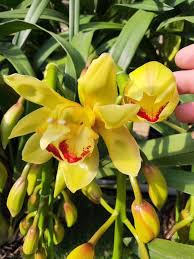How to Combine Sato Cymbidium Orchids with Other Plants in Your Garden

Sato Cymbidium orchids are not only stunning in their own right, but they also offer unique opportunities for creative combinations with other plants in the garden. These orchids, celebrated for their vibrant colors and long-lasting blooms, can serve as the focal point in a garden or blend harmoniously with various plant species. This article will explore effective strategies for combining Sato Cymbidium orchids with other plants to create visually appealing and diverse garden spaces.
## 1. Understanding the Unique Characteristics of Sato Cymbidium Orchids
Before we delve into the art of combining Sato Cymbidium orchids with other plants, it’s essential to understand their specific characteristics. These orchids are known for their:
– **Growth Habits:** Sato Cymbidium orchids typically have tall, arching leaves and produce multiple blooms on long spikes. They thrive in bright, indirect light, making them suitable for various garden settings.
– **Color Variety:** These orchids come in a range of colors, including shades of green, yellow, pink, red, and white. This variety offers numerous possibilities for pairing with other flowering plants.
– **Temperature and Humidity Preferences:** Sato Cymbidium orchids prefer moderate temperatures and high humidity. When selecting companion plants, it’s essential to choose those that share similar environmental needs.
## 2. Choosing Complementary Plants
When selecting companion plants for Sato Cymbidium orchids, consider the following factors to ensure a harmonious garden design:
### 2.1 Color Harmony
Color plays a crucial role in garden aesthetics. To create a visually appealing combination, choose plants with colors that complement or contrast with the orchids. For example:
– **Contrast:** Pairing vibrant orchids with dark foliage plants, such as **Heuchera** or **Bergenia**, can create a striking visual impact. The dark leaves enhance the brightness of the orchid blooms, making them stand out even more.
– **Complement:** Alternatively, selecting companion plants with similar hues, like **Lobelia** or **Impatiens**, can create a cohesive look. For example, yellow Sato Cymbidium orchids look stunning alongside yellow or white flowering plants.
### 2.2 Texture and Form
In addition to color, consider the texture and form of the companion plants. Mixing plants with varying leaf shapes, sizes, and structures can add depth and interest to the garden.
– **Foliage Varieties:** Incorporating plants with large, broad leaves, such as **Gunnera** or **Elephant Ear** (Alocasia), alongside the slender, arching leaves of Sato Cymbidium orchids can create a dynamic contrast.
– **Height Variation:** Use height differences to your advantage. Taller plants, such as **delphiniums** or **tall grasses** like **Miscanthus**, can serve as a backdrop to the shorter orchids, creating layers within the garden.
### 2.3 Growth Requirements
Ensure that the companion plants have similar growth requirements regarding light, water, and soil type. This compatibility will help create a thriving garden environment for all plants involved.
– **Light Needs:** Sato Cymbidium orchids thrive in bright, indirect light. Therefore, consider companion plants that also prefer similar lighting conditions, such as **fuchsia** or **ferns**.
– **Watering Needs:** Many companion plants, like **Astilbe** and **Bacopa**, enjoy moist conditions. However, avoid overly water-sensitive plants that may suffer from excessive moisture, as this can lead to root rot in orchids.
## 3. Ideal Combinations for Sato Cymbidium Orchids
Let’s explore some ideal combinations of Sato Cymbidium orchids with other plants that can create beautiful and harmonious garden arrangements.
### 3.1 Sato Cymbidium Orchids and Ferns
Ferns, such as **Boston Ferns** (Nephrolepis exaltata) or **Japanese Painted Ferns** (Athyrium niponicum), make excellent companions for Sato Cymbidium orchids. Their lush green fronds provide a soft, textured contrast to the upright spikes of orchids.
– **Design Tip:** Plant the ferns around the base of the orchids, creating a shaded and moist environment that benefits both plant types. The ferns will help retain moisture in the soil, creating an ideal microclimate for the orchids.
### 3.2 Sato Cymbidium Orchids and Shade-Loving Perennials
In areas with partial shade, combine Sato Cymbidium orchids with shade-loving perennials like **Astilbe** or **Hosta**. These plants thrive in similar conditions, providing a beautiful backdrop for the orchids.
– **Design Tip:** Group the orchids together with these perennials in clusters, ensuring that the height of the orchids adds vertical interest amidst the lush foliage of Hostas or the colorful blooms of Astilbe.
### 3.3 Sato Cymbidium Orchids and Seasonal Blooms
To extend the visual interest throughout the seasons, consider planting Sato Cymbidium orchids alongside seasonal bloomers like **Pansies** or **Snapdragons**.
– **Design Tip:** Choose seasonal plants that flower at different times, ensuring that when the orchids are out of bloom, other plants are in full display. For example, combining Sato Cymbidium orchids with spring bloomers ensures a vibrant garden throughout the year.
### 3.4 Sato Cymbidium Orchids and Succulents
For a unique garden design, consider combining Sato Cymbidium orchids with various succulents. Succulents, such as **Echeveria** or **Aloe**, have a distinct aesthetic that can contrast nicely with the elegance of orchids.
– **Design Tip:** Use succulents as ground cover in a rock garden setting where Sato Cymbidium orchids are positioned on raised beds or containers, creating a visually appealing arrangement that highlights both plant types.
### 3.5 Sato Cymbidium Orchids and Decorative Grasses
Pairing Sato Cymbidium orchids with ornamental grasses, such as **Blue Fescue** or **Maiden Grass**, can add movement and texture to the garden. The graceful sway of the grasses can complement the elegance of the orchids.
– **Design Tip:** Position the grasses behind the orchids to create a layered effect, ensuring the taller grasses frame the orchids without overshadowing them.
## 4. Container Combinations
In addition to in-ground plantings, Sato Cymbidium orchids thrive in containers, making them an ideal choice for patios, balconies, or small garden spaces. When potting orchids, consider creating mixed plant containers that combine the beauty of Sato Cymbidium orchids with complementary plants.
### 4.1 Vertical Gardens
For vertical gardens or wall planters, incorporate Sato Cymbidium orchids with trailing plants like **String of Pearls** or **Ivy**. The cascading vines can create a beautiful backdrop for the upright growth of the orchids.
– **Design Tip:** Choose a multi-tiered container design to maximize space, ensuring that the orchids are positioned in a way that their blooms are visible above the trailing plants.
### 4.2 Colorful Mixed Containers
Create colorful mixed containers by combining Sato Cymbidium orchids with other flowering plants like **Calibrachoa** or **Petunia**. The bright blooms of these annuals can complement the orchids’ striking colors.
– **Design Tip:** When designing mixed containers, vary the height and growth habits of the plants to create a visually dynamic arrangement. Place the orchids at the center, surrounded by the trailing and mounding annuals.
### 4.3 Herb and Orchid Gardens
For an aromatic twist, combine Sato Cymbidium orchids with herbs such as **Basil**, **Mint**, or **Thyme**. These herbs can thrive alongside the orchids while adding fragrance and culinary potential to the garden.
– **Design Tip:** Choose a larger pot to accommodate both the orchids and the herbs, ensuring that the herbs are planted in the foreground for easy access while maintaining visibility for the orchids.
## 5. Seasonal Considerations
When planning your garden design, consider the seasonal changes that may affect the appearance and health of your plants. Sato Cymbidium orchids are typically more resilient during specific months, and understanding these patterns can enhance your combinations.
### 5.1 Spring Blooms
Spring is an ideal time for planting Sato Cymbidium orchids alongside early bloomers. Pairing them with **Tulips** or **Daffodils** can create a stunning display, with the orchids blooming later in the season to carry the color forward.
– **Design Tip:** Arrange the spring bloomers in the foreground and the orchids in the background, allowing for a gradual height transition and continuous color.
### 5.2 Summer Vibrance
During summer, consider mixing Sato Cymbidium orchids with heat-tolerant perennials such as **Daylilies** or **Coneflowers**. These hardy plants can withstand warmer temperatures and complement the orchids beautifully.
– **Design Tip:** Utilize mulch or ground covers, such as **Creeping Thyme**, to retain moisture and provide a visually appealing contrast to the orchids.
### 5.3 Fall and Winter Interest
As the growing season winds down, consider how Sato Cymbidium orchids can remain visually appealing during fall and winter. Planting them with evergreens or deciduous plants that showcase autumn foliage can maintain interest.
– **Design Tip:** Create a garden plan that includes plants with varying leaf textures and colors for winter interest. Using planters with Sato Cymbidium orchids can keep the beauty of these flowers visible even in the colder months.
## 6. Conclusion
Combining Sato Cymbidium orchids with other plants in your garden opens up a world of creative possibilities. By understanding the unique characteristics of these orchids, considering complementary colors and textures, and selecting suitable companion plants, you can create a harmonious and visually stunning garden. In the next part of this article, we will delve deeper into specific combinations, maintenance tips, and strategies for enhancing the overall aesthetics of your garden featuring Sato Cymbidium orchids. Whether you’re a seasoned gardener or just starting, these insights will help you achieve a breathtaking garden space that showcases the beauty of these remarkable orchids.
# Combining Sato Cymbidium Orchids with Other Plants in the Garden (Part 2)
In the first part of this article, we explored the unique characteristics of Sato Cymbidium orchids, discussed how to choose complementary plants based on color, texture, and growth requirements, and examined ideal combinations for creating visually appealing garden spaces. This second part will delve deeper into specific combinations, maintenance tips, and additional strategies to enhance the aesthetics and overall health of your garden featuring Sato Cymbidium orchids.
## 7. Advanced Plant Pairings with Sato Cymbidium Orchids
Building on the combinations discussed previously, let’s explore more advanced plant pairings that not only enhance the beauty of Sato Cymbidium orchids but also promote biodiversity and ecological health in the garden.
### 7.1 Pairing with Native Plants
Incorporating native plants into your garden design can provide ecological benefits while complementing the beauty of Sato Cymbidium orchids. Native plants are adapted to the local environment, requiring less maintenance and supporting local wildlife.
– **Design Tip:** Consider planting Sato Cymbidium orchids alongside native flowering plants such as **Echinacea** (Coneflower) or **Rudbeckia** (Black-eyed Susan). These plants can thrive in similar conditions and attract pollinators like bees and butterflies, enhancing the garden’s biodiversity.
### 7.2 Combining with Tropical Foliage Plants
Tropical foliage plants can create a lush, exotic atmosphere when paired with Sato Cymbidium orchids. Plants such as **Philodendron**, **Monstera**, or **Banana Plants** (Musa) provide striking foliage that contrasts beautifully with the delicate flowers of the orchids.
– **Design Tip:** Position the tropical foliage plants behind or to the sides of the orchids to create depth in your garden design. The large leaves of these plants will highlight the elegance of the orchid blooms, making them stand out as focal points.
### 7.3 Enhancing with Aromatic Herbs
Aromatic herbs not only add fragrance to the garden but also provide culinary benefits. Pairing Sato Cymbidium orchids with herbs such as **Rosemary**, **Lavender**, or **Sage** can create a multi-sensory experience.
– **Design Tip:** Create a herb spiral or raised bed that includes Sato Cymbidium orchids alongside these herbs. The herbs will benefit from the humidity provided by the orchids, while the orchids will enjoy the well-drained soil often favored by herbs.
### 7.4 Incorporating Annuals for Seasonal Interest
Using annual plants can add vibrant color and seasonal interest to the garden. Pair Sato Cymbidium orchids with colorful annuals like **Zinnias**, **Marigolds**, or **Petunias** to ensure continuous blooms throughout the growing season.
– **Design Tip:** Arrange annuals around the base of the orchids, creating a cascading effect that draws the eye upwards to the orchid blooms. This layering creates depth and a lively garden atmosphere.
## 8. Care and Maintenance for Mixed Plantings
Once you’ve created a beautiful combination of Sato Cymbidium orchids and other plants, proper care and maintenance are essential to ensure the longevity and health of your garden. Here are some key maintenance tips for mixed plantings:
### 8.1 Watering Practices
Sato Cymbidium orchids thrive in well-drained conditions, so it’s crucial to manage watering carefully. Here’s how to ensure proper hydration for all plants in your garden:
– **Watering Schedule:** Establish a regular watering schedule that considers the needs of both orchids and companion plants. Monitor the moisture levels in the soil; Sato Cymbidium orchids typically require watering every 7 to 10 days, while other plants may have varying needs.
– **Soil Moisture Monitoring:** Use a moisture meter or your finger to check soil moisture levels. Ensure that the soil is moist but not soggy to prevent root rot in the orchids.
### 8.2 Fertilization Techniques
Proper fertilization is vital for maintaining the health of Sato Cymbidium orchids and their companions. Here are some tips on how to fertilize your mixed plantings effectively:
– **Balanced Fertilizers:** Use a balanced, water-soluble fertilizer that caters to the needs of all plants in the garden. For orchids, a 30-10-10 NPK ratio fertilizer diluted to half strength is often recommended.
– **Timing:** Fertilize during the growing season, typically from spring to early fall. Avoid fertilizing during the orchid’s dormant period in winter.
### 8.3 Pruning and Deadheading
Regular pruning and deadheading are essential for encouraging new growth and maintaining a tidy appearance in your garden.
– **Deadheading:** Remove spent blooms from Sato Cymbidium orchids and companion plants to promote further blooming. This practice helps redirect the plant’s energy toward new growth.
– **Pruning Companion Plants:** Trim back leggy or overgrown companion plants to maintain balance in your garden design. This can also prevent shading the orchids and ensure they receive adequate light.
## 9. Seasonal Considerations for Mixed Plantings
Each season brings different challenges and opportunities for garden design. Understanding how seasonal changes affect your Sato Cymbidium orchids and their companions will help you manage your garden effectively.
### 9.1 Spring Care
Spring is the time for new growth and blooming, making it crucial to provide proper care for your orchids and companions.
– **Pest Monitoring:** Inspect plants regularly for pests, particularly as they emerge in spring. Aphids and spider mites are common pests that can affect both orchids and companion plants.
– **Soil Refreshing:** Refresh the soil around your Sato Cymbidium orchids and companion plants by adding a layer of compost. This will provide nutrients for the upcoming growing season.
### 9.2 Summer Maintenance
Summer heat can stress both orchids and their companions, so it’s essential to maintain hydration and check for heat-related issues.
– **Mulching:** Apply a layer of organic mulch around the base of your plants to retain moisture and regulate soil temperature. This will benefit all plants, particularly during hot spells.
– **Shade Considerations:** During extreme heat, consider providing temporary shade for your orchids, especially if they are in direct sunlight. Using shade cloth can help reduce heat stress.
### 9.3 Fall Preparation
As the growing season comes to an end, take steps to prepare your garden for cooler temperatures.
– **Fall Cleanup:** Remove any dead or diseased plant material from the garden to reduce the risk of pests and diseases overwintering.
– **Preparing for Dormancy:** For Sato Cymbidium orchids, begin reducing watering and fertilization as they enter dormancy. Ensure they have a dry resting period to promote healthy growth in spring.
### 9.4 Winter Protection
Winter can be challenging for outdoor plants, so consider how to protect your Sato Cymbidium orchids and their companions during cold months.
– **Winter Mulching:** Add an extra layer of mulch around the base of your orchids and companion plants to protect the roots from freezing temperatures.
– **Indoor Transition:** If you grow orchids in containers, consider bringing them indoors during the coldest months. Place them in a bright spot with indirect light to maintain their health.
## 10. Creating a Cohesive Design
To achieve a cohesive garden design, consider the following principles:
### 10.1 Repeating Patterns
Utilize repeating patterns of color, texture, or plant types to create a harmonious garden. For instance, if you have multiple Sato Cymbidium orchids, space them evenly throughout the garden, allowing for a balanced look.
– **Design Tip:** Group the orchids with a consistent companion plant, such as ferns or shade-tolerant perennials, to create a seamless flow throughout the garden.
### 10.2 Focal Points
Sato Cymbidium orchids can serve as focal points in your garden. Position them in areas where they will draw attention, such as at the entrance of a garden path or in prominent locations within mixed borders.
– **Design Tip:** Use taller companion plants to frame the orchids, creating a visual anchor that draws the eye toward the blooms.
### 10.3 Seasonal Interest and Variety
To maintain year-round interest, include plants that bloom at different times throughout the seasons. By selecting a variety of plants with staggered blooming periods, you can ensure that there is always something vibrant in your garden.
– **Design Tip:** Create a planting schedule that outlines when each plant species blooms, helping you choose the right companions to enhance seasonal beauty.
## 11. Conclusion
Combining Sato Cymbidium orchids with other plants in your garden opens up endless possibilities for creativity and beauty. By selecting complementary plants based on color, texture, and growth requirements, you can create stunning arrangements that enhance the charm of these orchids.
With proper care and maintenance, your mixed plantings can thrive, providing a dynamic and vibrant garden space. Emphasizing seasonal considerations, cohesive design principles, and advanced plant pairings will help you create a flourishing environment for Sato Cymbidium orchids and their companions.
In the world of gardening, the journey of combining plants is as rewarding as the final result. Through experimentation and careful planning, you can achieve a garden that not only showcases the beauty of Sato Cymbidium orchids but also supports a diverse ecosystem, inviting pollinators and providing a haven for relaxation and enjoyment. Happy gardening!

